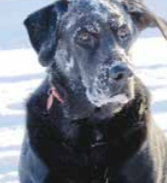
Oh, the weather outside is frightful . . . yet, like clockwork, my dog wants out to play every day at 7 a.m. and 4:30 p.m.
It’s good for me, too. It’s a forced break from the computer, a chance at fresh air which clears my mind and stretches my legs. Dogs need activity every day to keep them fit and healthy. And remember, a tired dog is a well-behaved dog.
Winter opens opportunities to explore new activities. Tracing its roots back to Norway, skijoring is a fun winter activity for you and your dog — think dogsledding, but with a person on skis instead of a sled.
A dog, a pair of cross-country skis and some basic harnessing are all you need to get started. Outfit your pup with a pulling harness and attach one end to a special shock-absorbing skijoring line. Attach the other end to yourself using a climbing harness or a specialized skijoring belt.
One dog should be able to rocket you along a groomed trail, but it might take as many as three dogs if you’re in deep, fresh snow or heading offtrail. Larger dogs, like Labrador retrievers, are strong pullers, but most dogs can participate.
Skijoring dogs follow the same commands as sledding dogs: “Hike” to start running, “gee” and “haw” to make left and right turns, and “whoa” to stop. Unleash your inner musher with skijoring this winter!

catching snowballs.
She doesn’t throw
them back at her
owner
Speaking of mushers, long ago, Canadian mushers discovered that wax prevented ice build-up on their sled dog’s feet.
Warm dog feet melt snow and create painful ice balls between the toes. If not removed promptly, they can cause cuts and ulcers.
Musher’s Secret (https://musherssecret.net) is a food-grade wax that forms a breathable barrier on the foot. Because it prevents ice build-up, plus many other benefits, it has found a permanent home in my doggie day bag.
It also shields feet from scrapes in rough terrain and protects against chemical burns and cracking from road salt and ice-melt, so you can still use it even if you aren’t in training for the Canadian Challenge, a 600-km dog sled race in northern Saskatchewan (https://www.canadianchallenge.com/). Neatly trimmed hair on the paws also lessens ice build-up.
Dog boots protect the paws from ice, too, and have the added benefit of insulating the feet. It takes a bit of time and training for most dogs to get used to them.
In extreme cold, I continually monitor my dog’s feet. A dog that holds a paw in the air to ‘warm’ it is getting too cold.
If I see this, I’ll hold the paw in my bare hand to help warm it, buying time to get my pooch back indoors. Tails and ears are also susceptible to the cold, and getting wet makes it worse.
I have a yellow lab who handles the cold well, yet on the extra-cold days, I dress her in a jacket or parka that keeps her chest and underbelly warm while I watch her feet for signs of frostnip.
As the temperature drops, a dog’s energy needs increase. An active dog (like a dogsledding or skijoring pooch) may need twice as much food in winter! I feed a high-protein/high-fat dog food to fuel these high-energy activities.

to keep your dog
warmer in the winter.
I provide free access to water that aids with the digestion of those extra calories. A little fat on their ribs is okay, because it adds some insulation while providing an energy reserve, but it’s still essential to maintain a healthy body condition. In the spring, remember to switch back to a regular diet.
We’re experiencing an unseasonably warm winter. With mild temperatures come thin ice. On our walks, I avoid areas along rivers, storm channels, and aerated ponds. It’s hard to tell where the thin spots are, and if my pup falls in, it will put me and others at risk to rescue her.
My dog loves playing in the snow and catching snowballs. As she ages, I’ve noticed playing in deep snow stresses her joints, often to the point where she’s stiff at night.
I’m cautious to stay within her capabilities — and my own — to prevent injury or soreness that would prevent us from our daily outdoor excursions.
Snow and sub-zero temperature are no excuse to stay indoors for you or your dog — get out there and enjoy the winter wonderland! Stay safe and have fun.
Now please excuse me, it’s 4:30, and my dog is waiting.
-Lowell Strauss

Leave a Reply